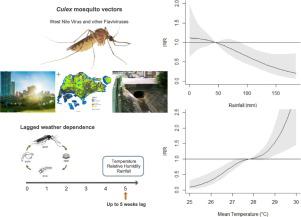Science of the Total Environment ( IF 8.2 ) Pub Date : 2020-09-21 , DOI: 10.1016/j.scitotenv.2020.142420 Stacy Soh , Joel Aik

|
Culex mosquitoes are important vectors of West Nile Virus (WNV), St. Louis Encephalitis Virus (SLEV) and Japanese Encephalitis Virus (JEV). Climate change is expected to alter their ability to spread diseases in human populations. Studies examining the influence of climate variability on Culex mosquitoes in South East Asia are scarce.
We examined the influence of climate variability on reported Culex mosquito larval habitats from 2009-2018 in Singapore. We analysed the non-linear immediate and lagged weather dependence of Culex habitats over 5 weeks in negative binomial regression models using nationally representative data. We adjusted for the effects of long-term trend, seasonality, public holidays and autocorrelation.
There were 41,170 reported Culex larval habitats over the study period. Non-residential premises were associated with more reports of habitats compared to residential premises [Rate Ratio (RR): 113.9, 95% CI: 110.9, 116.9]. Larvae in more than 90% of these habitats were entomologically identified as Culex quinquefasciatus. In residences, every 10 mm increase in rainfall above a 90 mm threshold was associated with a 10.1% [Incidence Rate Ratio (IRR): 0.899, 95% CI: 0.836, 0.968] cumulative decline in larval habitats. Public holidays were not significantly included in the model analysing larval habitats in residences. In non-residences, a 1°C increase in the ambient air temperature with respect to the mean was associated with a 36.0% (IRR: 1.360, 95% CI: 1.057, 1.749) cumulative increase in Culex larval habitats. Public holidays were associated with a decline in Culex larval habitats in the same week.
Our study provides evidence of how ambient air temperature and rainfall variability influences the abundance of Culex mosquito larval habitats. Our findings support the utility of using weather data in predictive models to inform the timing of vector control measures aimed at reducing the risk of WNV and other Culex-borne flavivirus transmission in urban areas.
中文翻译:

西尼罗河病毒和其他黄病毒的库蚊灭蚊载体丰富:新加坡降雨和温度依赖性的时间序列分析
库蚊是西尼罗河病毒(WNV),圣路易斯脑炎病毒(SLEV)和日本脑炎病毒(JEV)的重要载体。预期气候变化将改变其在人群中传播疾病的能力。缺乏研究气候变化对东南亚库蚊的影响的研究。
我们研究了2009- 2018年新加坡气候变化对报道的库蚊蚊幼虫栖息地的影响。我们使用全国代表性的数据,在负二项式回归模型中分析了库克斯栖息地超过5周的非线性立即和滞后天气依赖性。我们针对长期趋势,季节性,公共假期和自相关的影响进行了调整。
在研究期间,有41,170个报告的库蚊幼虫栖息地。与住宅场所相比,非住宅场所与栖息地报告的相关性更高[比率(RR):113.9,95%CI:110.9,116.9]。在昆虫学上,超过90%的这些栖息地中的幼虫被鉴定为库蚊(Culex quinquefasciatus)。在住宅中,超过90毫米阈值的降雨量每增加10毫米,幼虫栖息地的累积下降就将导致10.1%的发生率[IRR]:0.899,95%CI:0.836,0.968]。在分析住宅中幼虫栖息地的模型中,公共假期没有显着包括在内。在非住宅,在周围空气温度的增加1℃相对于平均用36.0%相关(IRR:1.360; 95%CI:1.057,1.749)在累计增加库蚊幼虫的栖息地。公众假期与同一周库蚊幼虫栖息地的减少有关。
我们的研究提供了环境空气温度和降雨变化如何影响库蚊蚊幼虫栖息地丰富度的证据。我们的研究结果支持使用预测模型气象数据,通知旨在减少WNV的风险和其他媒介控制措施的时机的效用库蚊在城区-borne黄病毒传播。











































 京公网安备 11010802027423号
京公网安备 11010802027423号